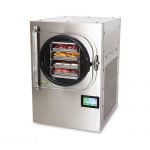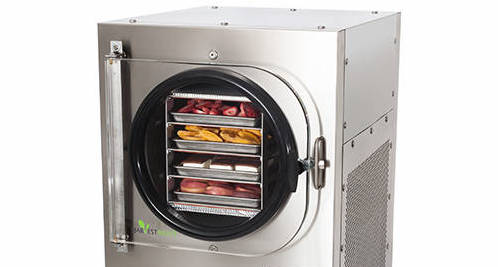Our family began our self-sufficiency journey approximately 15 to 20 years ago at an LDS Home Storage Center location and we did not have a focused plan (Yes JW,R I should have thoroughly reviewed the list of lists, my bad!). In hindsight, we would not have gone as heavy as we did in wheat berries, beans and rice. However, that is water under the bridge at this point as we slowly work our way through the original purchases (wheat berry meatloaf anyone?). Since that time, our food storage has greatly diversified and if you have priced out certain freeze-dried items lately, you realize the prices can be quite high.
If we take a slight detour back to 2014, I remember reading a multi-part article on SurvivalBlog.com which was a review for the Harvest Right Freeze Dryer. He followed up with a retrospective review, in 2017. It was after reading Mr. Latimer’s article that I began to consider the purchase of one of these units. Several times during the years since the publishing of his article, I would vacillate on the concept of purchasing one of the units. It took me quite a while to pull the trigger on one, and in retrospect, we should have done it years ago. Last year, when we decided to put down our hard-earned Federal Reserve Notes and purchase the medium-sized freeze dryer unit from Harvest Right, we made a pinky swear that if we were to make this investment, we would use the machine on a regular basis and not just use it once in a blue moon. The intent of this article is not to update the review done by the previous author, but rather, to help others in the decision-making process by illustrating the potential return on investment associated with this appliance.
In full disclosure to the reading audience, at the time of writing this, our experience is limited with the dryer. We have had the dryer for two- and one-half months, and so far, only 16 batches have been completed but we feel we are getting our money’s worth from the machine thus far. Below I will provide two examples of the foods we have processed and then make the comparison of commercial procurement versus doing it yourself. The two examples that will be presented are biased towards higher dollar commercially available products and we have processed other foods (examples being yogurt, dill pickle chips, leftovers, etc.) that would still be decent savings, but likely not as drastic.
The first cost comparison will be freeze-drying cheese, specifically mozzarella. A few of the parameters/assumptions used for this comparison are as follows:
• We are using mylar bags to package versus #10 cans as we made the decision to not yet invest in a can sealer.
• The cost of electricity is based on what others have said their running costs were on average. At first blush, this assumed cost seems reasonable based on the average run time of 24 to 30 hours.
• The purchase cost per #10 can was determined by performing an Internet search and if the item happened to be on sale at the time, that was the price used in the spreadsheet.
• The cheese was purchased already shredded from our local restaurant supply store.
Some Cost Comparisons
The spreadsheet below shows the comparison of home-prepared freeze-dried mozzarella versus commercial freeze-dried mozzarella.
| Homemade | Store 1 | Store 2 | Store 3 | Store 4 | Store 5 | Store 6 | |
| Cost Per gram | $0.01 | $0.10 | $0.07 | $0.06 | $0.04 | $0.05 | $0.07 |
| Cost per kilogram | $14.25 | $96.79 | $71.25 | $56.66 | $44.07 | $48.85 | $66.10 |
| Cost per #10 can | Not Applicable | $75.69 | $60.99 | $44.99 | $34.99 | $42.99 | $59.95 |
Home prepared cost basis:
Home prepared cost basis:
| Five-pound bag of cheese | $12.00 | |
| Mylar bags (4) | $2.00 | |
| O2 Absorbers (4) | $1.00 | |
| Electric | $2.00 | |
| Total Cost of Materials | $17.00 | |
| Dried Weight of Product (in grams) | 1,193 | |
| Cost per gram | $0.01 |
In summary, the final combined weight of the freeze-dried product was 1,193 grams which is equivalent to 1.5 cans of the least expensive cheese listed above. That equates to a commercial purchase price of $69.98, so a bit more than four times the cost of doing it at home (not accounting for the machine purchase price).
The final cost comparison will be freeze-drying breaded chicken tenders. A few of the parameters/assumptions used for this comparison are as follows:
• We are using mylar bags to package versus #10 cans as we made the decision to not yet invest in a can sealer.
• The cost of electricity is based on what others have said their running costs were on average. At first blush, this assumed cost seems reasonable based on the average run time of 24 to 30 hours.
• The purchase cost per #10 can was determined by performing an Internet search and if the item happened to be on sale at the time, that was the price used in the spreadsheet.
• The items with an asterisk below are based on the cost of freeze-dried chicken breasts so those costs are not “apples to apples”.
• The breaded chicken tenders were purchased at our local bulk warehouse store.
The spreadsheet below shows the comparison of home-prepared freeze-dried breaded chicken tenders vs commercial freeze-dried breaded chicken tenders.
| Homemade | Store 1 | Store 2 | Store 3* | Store 4* | Store 5* | |
| Cost Per gram | $0.02 | $0.16 | $0.15 | $0.12 | $0.12 | $0.10 |
| Cost per KG | $16.21 | $163.02 | $148.99 | $116.08 | $116.38 | $95.77 |
| Cost per #10 can | NA | $59.99 | $54.83 | $55.95 | $65.99 | $49.99 |
Home prepared cost basis:
| Four-pound bag of breaded chicken tenders (2) | $25.96 | |
| Mylar bags (6) | $3.00 | |
| O2 Absorbers (6) | $1.50 | |
| Electric | $2.00 | |
| Total Cost of Materials | $32.46 | |
| Dried Weight of Product (in grams) | 2,003 | |
| Cost per gram | $0.02 |
In summary, the final combined weight of the freeze-dried product was 2,003 grams which is equivalent to 5.44 cans of the breaded chicken tenders listed above. That equates to a commercial purchase price of $298.28, so almost nine times the price of doing it at home (not accounting for the machine purchase price).
 Because grown adults sadly cannot live on chicken tenders and mozzarella cheese alone, in addition to the examples shown above for cost savings in outright purchases of pre-packaged freeze-dried items, we are also running batches of leftovers, which cuts down on food waste. Who wants to eat pork, potato and green chili stew for four days straight when you can eat it for two days and freeze dry the rest in two portion packs to whip out at a moment’s notice? It is great for making up small pouches that can be taken to work in your handbag or briefcase, ensuring a hot, healthy meal even if you did not do your meal prep for the week. And since you made the meals that are in your pouch, you know exactly what is in them, from the sodium content to the calorie count to the actual ingredients you used.
Because grown adults sadly cannot live on chicken tenders and mozzarella cheese alone, in addition to the examples shown above for cost savings in outright purchases of pre-packaged freeze-dried items, we are also running batches of leftovers, which cuts down on food waste. Who wants to eat pork, potato and green chili stew for four days straight when you can eat it for two days and freeze dry the rest in two portion packs to whip out at a moment’s notice? It is great for making up small pouches that can be taken to work in your handbag or briefcase, ensuring a hot, healthy meal even if you did not do your meal prep for the week. And since you made the meals that are in your pouch, you know exactly what is in them, from the sodium content to the calorie count to the actual ingredients you used.
On a side note, a few of the lessons learned so far include making sure to purchase a second set of trays ahead of time to be more efficient. This way, when something is being processed in the freeze dryer, you can have foods pre-freezing and ready to go as soon as a batch is complete. Another thing is the storage of the filled mylar bags. We are using stackable plastic totes to store the filled mylar bags in as this provides additional protection from critters. For the items we are using daily, they get stored in Mason jars.
We have also found ourselves cooking out of the freezer more, emptying space in that power suck of an appliance. At the rate we are going, we could eliminate one of our deep freezers, thereby saving the power draw and have one less concern if the power goes out due to a weather event.
We should mention a secondary, but also useful upshot of the unit: healthy snacks. Freeze-dried yogurt drops, pineapple pieces, pickle chips, veggie bites, etc. have all taken the place of other less healthy snacks in our house. It seems like a small thing, but a bag of pickles chips taken for lunch in place of a bag of potato chips can really add up over the course of time. And there is always the perfunctory Astronaut Ice Cream sandwiches if you are still on the fence.
Conclusion
In conclusion, based on the numbers outlined above, we could see our return on investment after 12 runs of breaded chicken tenders, however, that is not realistic regarding our usage of the machine but “your mileage may vary”. In our circumstances, we are running a variety of products in the machine (as this is being typed, there are two trays of tomato salsa and two trays of guacamole salsa being processed) and we expect that the machine should pay for itself between the six- and twelve-month mark, and it will give us a much greater diversity of stored foods. While collecting guns and ammunition is a far more romantic prepper vision, I am thinking that the odds of me needing to eat in the future are greater than needing to arm a platoon. Hopefully, for all our sakes, I am right.










